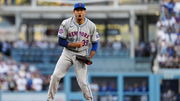

Aaron Judge‘s recent controversial slide into second base during the New York Yankees’ game against the Milwaukee Brewers ignited a firestorm of debate. The play, where Judge’s raised arm deflected a throw that seemed to have obstructed the fielder, has reignited discussions about baserunning aggression. After all, there is an elusive line between strategy and interference.
Watch What’s Trending Now!
Interestingly, this is not the first time a high-profile player has been embroiled in a similar controversy. There was an incident that involved the former Yankees shortstop Alex Rodriguez. As legendary as his legacy is, A-Rod is a name that was associated with a lot of controversies in his heyday. And a ‘hip block’ was one as well.
ADVERTISEMENT
Aaron Judge and Alex Rodriguez had a similar experience
As per mentioned in the podcast, the Foul Territory, “A-Rod actually did that against us too in the game too. Stuck his hip into a ball and what’d they call it? Nothing. He went ‘Oh nothing. There’s a whole other story to that.” While details on why the umpire did not call that play remain unclear, it drew a parallel to Judge’s slide.
"It's the one thing you can do still to try and break up a double play" says @ErikKratz31 of the Aaron Judge oven-mitt deflection on his slide vs the Brewers.
"I think everybody should do it."
▶️ https://t.co/hJhalZFvxx pic.twitter.com/6nY5fbfnkY
— Foul Territory (@FoulTerritoryTV) April 29, 2024
In A-Rod’s case, whether there was video evidence or not, is unknown. Whether the missed call was declared an error is also unknown. While there has not been any clarity on that particular play by A-Rod, it is still worth wondering: why did Aaron Judge’s play cause so much chatter then? Was A-Rod’s ‘interference’ not similar to Judge’s?
ADVERTISEMENT
Well, first of all, a key distinction to consider is the difference between a “hip block” and incidental contact would be key in identifying whether there was an interference or not. A forceful hip block curated to impede the fielder is a clear violation. However, unintentional contact during a slide might be viewed differently.
Top Stories
Critical Bo Bichette Warning Looms as Blue Jays Face Pressure to Shed Another $20M for Postseason Hero Reunion

Edwin Díaz Publicly Snubs Mets after Kiké Hernández Claims Credit Behind Iconic Dodgers Signing

Bronx Veteran Argues Yankees Have the Best Rotation Despite $1.8B AL Dark horse’s Cutthroat Offseason Approach

Braves Shock MLB World by Signing Korean SS for a Hefty $20 Million

Who Is Bo Bichette’s Fiancée? Everything to Know About Alexis

ADVERTISEMENT
Will MLB make it look into reinforcing missed calls?
The call back to Rodriguez’s situation back when he played for the Yankees does present an interesting parallel to Judge’s slide. While both scenarios involve a baserunner making contact that potentially disrupts the play, there are some differences. The intricacies of identifying whether it was intentional or unintentional will be the game changer, no matter which part of the body it was; arm or hip.
This forgotten A-Rod incident, casts new light on Judge’s play and the complexities of baserunning. It underlines the subjectivity involved in such calls and the ongoing debate about the line between aggressive baserunning and obstruction. Maybe, as MLB continues to evolve, clearer definitions and stricter enforcement around these plays would be necessary to avoid speculative judgements.
ADVERTISEMENT
ADVERTISEMENT
ADVERTISEMENT

